Through FOIA queries Medic has obtained numerous military and Red Cross documents pertaining to the war experiences of Ernest Hemingway. The files are embedded in the text below.
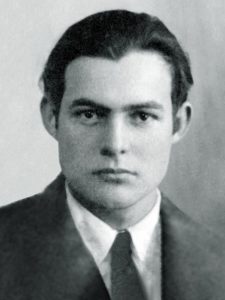 Ernest Miller Hemingway (1899 – 1961) was an American journalist, novelist, short-story writer, and noted sportsman. His understated style—which he termed the iceberg theory—had a strong influence on 20th-century fiction, while his adventurous lifestyle and his public image brought him admiration from later generations. He published seven novels, six short-story collections, and two non-fiction works. Three of his novels, four short-story collections, and three non-fiction works were published posthumously. Many of his works are considered classics of American literature. He won the Nobel Prize in Literature in 1954.
Ernest Miller Hemingway (1899 – 1961) was an American journalist, novelist, short-story writer, and noted sportsman. His understated style—which he termed the iceberg theory—had a strong influence on 20th-century fiction, while his adventurous lifestyle and his public image brought him admiration from later generations. He published seven novels, six short-story collections, and two non-fiction works. Three of his novels, four short-story collections, and three non-fiction works were published posthumously. Many of his works are considered classics of American literature. He won the Nobel Prize in Literature in 1954.
Early in 1918, after being turned down by the US Army, Navy and Marines because of poor eyesight, Hemingway joined the Red Cross to become an ambulance driver in Italy.
Medic has obtained documents relating to Hemingway’s Red Cross service.
On his first day in Milan, Hemingway was sent to the scene of a munitions factory explosion, where rescuers retrieved the shredded remains of female workers. He described the incident in his non-fiction book Death in the Afternoon: “I remember that after we searched quite thoroughly for the complete dead we collected fragments.” A few days later, he was stationed at Fossalta di Piave.
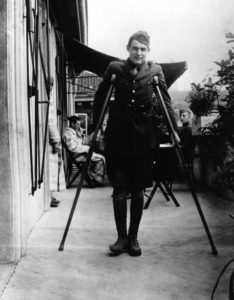 On July 8,1918 Hemingway was seriously wounded by mortar fire, having just returned from the canteen bringing chocolate and cigarettes for the men at the front line. Despite his injuries (which required six months to heal), he assisted Italian soldiers to safety, for which he received the Italian Silver Medal of Bravery. He was 18 at the time. Hemingway later said of the incident: “When you go to war as a boy you have a great illusion of immortality. Other people get killed; not you … Then when you are badly wounded the first time you lose that illusion and you know it can happen to you.”
On July 8,1918 Hemingway was seriously wounded by mortar fire, having just returned from the canteen bringing chocolate and cigarettes for the men at the front line. Despite his injuries (which required six months to heal), he assisted Italian soldiers to safety, for which he received the Italian Silver Medal of Bravery. He was 18 at the time. Hemingway later said of the incident: “When you go to war as a boy you have a great illusion of immortality. Other people get killed; not you … Then when you are badly wounded the first time you lose that illusion and you know it can happen to you.”
During the Spanish Civil War Hemingway was present at the Battle of the Ebro, the last republican stand. He was among the last journalists to leave the battle.
In the 40s and 50s Hemingway lived in Cuba. Before the United Stated entered WWII he convinced the Cuban government to help him refit his boat Pilar to patrol and ambush German submarines off the coast of Cuba. As a result, J. Edgar Hoover had an agent in Havana surveil Hemingway through the 1950s.
All Hemingway FBI files are available on The Vault, a website run by the FBI. Here are several files: File 1, File 2, File 3, File 4, File 5.
A 2009 book suggests that during the 1950s Hemingway may have been recruited to work for Soviet intelligence agents under the code name “Agent Argo”.
As a war correspondent in WWII Hemingway was present at the Normandy Landings. His LST came within sight of Omaha Beach before coming under enemy fire and turning back. Hemingway later wrote in Collier’s magazine that he could see “the first, second, third, fourth and fifth waves of [the landing troops] lay where they had fallen, looking like so many heavily laden bundles on the flat pebbly stretch between the sea and first cover.” On that day none of the correspondents were allowed to land and Hemingway returned to the Dorothea Dix.
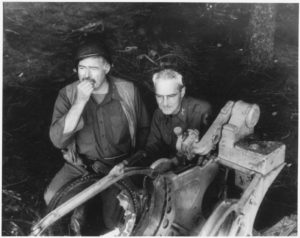 Late in July, Hemingway attached himself to the 22nd Infantry Regiment commanded by Col. Charles ‘Buck’ Lanham, as it drove toward Paris. Hemingway also headed a small band of village militia in Rambouillet outside of Paris. He stored ammo and uniforms in Ritz hotel room and lead a group of Free French guerillas who scouted the roads to Paris and gave valuable intel to the Allied armies.
Late in July, Hemingway attached himself to the 22nd Infantry Regiment commanded by Col. Charles ‘Buck’ Lanham, as it drove toward Paris. Hemingway also headed a small band of village militia in Rambouillet outside of Paris. He stored ammo and uniforms in Ritz hotel room and lead a group of Free French guerillas who scouted the roads to Paris and gave valuable intel to the Allied armies.
For gun running, and as a war correspondent leading armed combatants, Hemingway was investigated by the military. Hemingway claimed that he only offered advice but may have lied under oath. One wonders if the Army secretly approved this covert mission. For his unprofessional behavior other war correspondents held Hemingway in low regard.
Medic has obtained the once secret memos and correspondence relating to the Army IG investigation of Ernest Hemingway.
Coincidentally, the June 2019 issue of Strand Magazine includes an previously unpublished short story by Hemingway titled “A Room on the Garden Side.” Written in 1956, the story takes place at the Ritz Hotel in Paris and is narrated by a infantry officer named Robert or “Papa” and depicts soldiers hopeful the war will soon end, even as they smuggle arms. The story appears to correspond with the combat activity allegations made against Hemingway, which were refuted in the once secret Report of Investigation, Alleged Combat Activities of Mr. Ernest Hemingway (Colliers) of 23 September 1944.
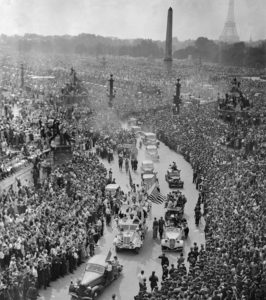 On August 25, Hemingway was present at the liberation of Paris. Contrary to legend he was not the first into the city, and did not liberate the Ritz. Later that year, he was present at heavy fighting in the Battle of Hürtgen Forest. On December 17, 1944, in poor health, Hemingway had himself driven to Luxembourg to cover The Battle of the Bulge but was hospitalized with pneumonia. By the time that he recovered the fighting was nearly done.
On August 25, Hemingway was present at the liberation of Paris. Contrary to legend he was not the first into the city, and did not liberate the Ritz. Later that year, he was present at heavy fighting in the Battle of Hürtgen Forest. On December 17, 1944, in poor health, Hemingway had himself driven to Luxembourg to cover The Battle of the Bulge but was hospitalized with pneumonia. By the time that he recovered the fighting was nearly done.
In 1947, Hemingway was awarded a Bronze Star for his bravery during World War II. He was recognized for his valor, having been “under fire in combat areas in order to obtain an accurate picture of conditions”, with the commendation that “through his talent of expression, Mr. Hemingway enabled readers to obtain a vivid picture of the difficulties and triumphs of the front-line soldier and his organization in combat”.
___________
sources:
wikipedia
The Hemingway Society
National Archives: Hemingway on War and Its Aftermath
The Strand Magazine: The Story Behind Hemingway’s “A Room On The Garden Side
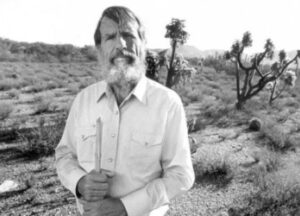
Ernest Hemingway
Through FOIA queries Medic has obtained numerous military and Red Cross documents pertaining to the war experiences of Ernest Hemingway. The files are embedded in the text below.
Early in 1918, after being turned down by the US Army, Navy and Marines because of poor eyesight, Hemingway joined the Red Cross to become an ambulance driver in Italy.
Medic has obtained documents relating to Hemingway’s Red Cross service.
On his first day in Milan, Hemingway was sent to the scene of a munitions factory explosion, where rescuers retrieved the shredded remains of female workers. He described the incident in his non-fiction book Death in the Afternoon: “I remember that after we searched quite thoroughly for the complete dead we collected fragments.” A few days later, he was stationed at Fossalta di Piave.
During the Spanish Civil War Hemingway was present at the Battle of the Ebro, the last republican stand. He was among the last journalists to leave the battle.
In the 40s and 50s Hemingway lived in Cuba. Before the United Stated entered WWII he convinced the Cuban government to help him refit his boat Pilar to patrol and ambush German submarines off the coast of Cuba. As a result, J. Edgar Hoover had an agent in Havana surveil Hemingway through the 1950s.
All Hemingway FBI files are available on The Vault, a website run by the FBI. Here are several files: File 1, File 2, File 3, File 4, File 5.
A 2009 book suggests that during the 1950s Hemingway may have been recruited to work for Soviet intelligence agents under the code name “Agent Argo”.
As a war correspondent in WWII Hemingway was present at the Normandy Landings. His LST came within sight of Omaha Beach before coming under enemy fire and turning back. Hemingway later wrote in Collier’s magazine that he could see “the first, second, third, fourth and fifth waves of [the landing troops] lay where they had fallen, looking like so many heavily laden bundles on the flat pebbly stretch between the sea and first cover.” On that day none of the correspondents were allowed to land and Hemingway returned to the Dorothea Dix.
For gun running, and as a war correspondent leading armed combatants, Hemingway was investigated by the military. Hemingway claimed that he only offered advice but may have lied under oath. One wonders if the Army secretly approved this covert mission. For his unprofessional behavior other war correspondents held Hemingway in low regard.
Medic has obtained the once secret memos and correspondence relating to the Army IG investigation of Ernest Hemingway.
Coincidentally, the June 2019 issue of Strand Magazine includes an previously unpublished short story by Hemingway titled “A Room on the Garden Side.” Written in 1956, the story takes place at the Ritz Hotel in Paris and is narrated by a infantry officer named Robert or “Papa” and depicts soldiers hopeful the war will soon end, even as they smuggle arms. The story appears to correspond with the combat activity allegations made against Hemingway, which were refuted in the once secret Report of Investigation, Alleged Combat Activities of Mr. Ernest Hemingway (Colliers) of 23 September 1944.
In 1947, Hemingway was awarded a Bronze Star for his bravery during World War II. He was recognized for his valor, having been “under fire in combat areas in order to obtain an accurate picture of conditions”, with the commendation that “through his talent of expression, Mr. Hemingway enabled readers to obtain a vivid picture of the difficulties and triumphs of the front-line soldier and his organization in combat”.
___________
sources:
wikipedia
The Hemingway Society
National Archives: Hemingway on War and Its Aftermath
The Strand Magazine: The Story Behind Hemingway’s “A Room On The Garden Side